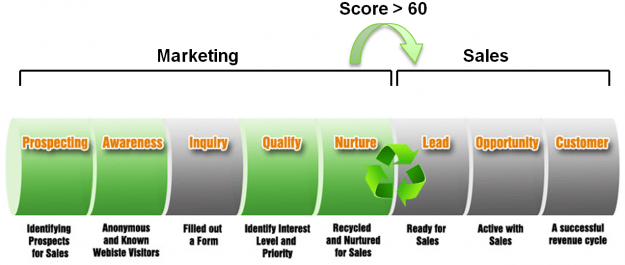Sales Pipeline
 Sales pipeline, sales cycle, pipeline and revenue cycle are just a few terms thrown around in sales and marketing organizations across the globe to define the life cycle of a sale. There’s no single name for opportunities moving from initial contact to customer. In fact, the health care industry adds to the confusion by defining a revenue cycle as “all administrative and clinical functions that contribute to the capture, management and collection of patient service revenue” according to fairview.org , terminology far different from what’s used in B2C and B2B sales. Putting health care aside, let’s keep it simple and use the traditional name of a “sales pipeline”. Although the name is inconsistent, what is consistent is the mismanagement of the sales pipeline. Organizations should focus on three best practices to better manage their sales pipeline; define the sales pipeline, split the sales pipeline, and keep the sales pipeline/database clean.
Sales pipeline, sales cycle, pipeline and revenue cycle are just a few terms thrown around in sales and marketing organizations across the globe to define the life cycle of a sale. There’s no single name for opportunities moving from initial contact to customer. In fact, the health care industry adds to the confusion by defining a revenue cycle as “all administrative and clinical functions that contribute to the capture, management and collection of patient service revenue” according to fairview.org , terminology far different from what’s used in B2C and B2B sales. Putting health care aside, let’s keep it simple and use the traditional name of a “sales pipeline”. Although the name is inconsistent, what is consistent is the mismanagement of the sales pipeline. Organizations should focus on three best practices to better manage their sales pipeline; define the sales pipeline, split the sales pipeline, and keep the sales pipeline/database clean.
First, let’s get on common ground. The sales pipeline typically consists of four stages; inquiry, lead, opportunity and customer. Inquiry and “contact” can be used interchangeably. The idea is the name is a new or existing contact in your database. At some point the contact becomes a lead and ready for sales. Then, the lead progresses to an opportunity and eventually a customer.
The diagram above is a rudimentary version of a sales pipeline and is entirely too basic for most organizations. This segues into our first suggestion:
1. Define your sales pipeline
Sit down with leaders of your organization from sales, marketing and operations. Take input from the sales force and come up with a definition for your sales pipeline. The definition should be a collection of stages in conjunction with probability. Probability is your confidence level the lead will close. Use a CRM system such as Salesforce.com to help track the life cycle of your lead as they advance through each stage. Below is an example of the stages and probability of a sales pipeline.
- Prospect New (10% probability – marketing lead or trade show follow-up)
- Prospect Engaged (20% probability – web meeting, phone contact)
- Evaluation (30% probability – demo/presentation completed)
- Budget Qualification (40% probability – requirements discovery phase)
- Proposal Submitted (50% probability – confirmed budget, testing commitment)
- Technically Selected (60% probability – building ROI, business justification)
- Contract Negotiation (70% probability – reviewing proposals, technically selected)
- Final Signature (80% probability – selected, waiting for signed agreement and/or final approval)
- In Purchasing (90% probability – waiting for purchase order)
- Closed (100% – purchase order received)
The above stages breaks down the sales pipeline beginning with the lead stage into a more granular view, which is recommended. Taking a more granular view on the pipeline stages prior to the lead stage we discover “hidden” stages that must be addressed, added in green in the diagram below.

Most organizations fail to recognize the green stages and neglect making them part of their process. What happened before the contact was a lead? Some form of prospecting must have occurred. For example, the contact may have been collected from cold calls, trade shows, website lead tracking or list buying. After the appropriate folks are made aware of the contact the contact must be qualified. If the contact is unqualified, they should be nurtured until they qualify as a “lead” ready for sales. This segues into our second suggestion:
2. Split your sales pipeline into two
Many sales and marketing organizations disagree on the definition of a lead. Sales tend to have criteria for a lead and marketing tends to call any contact a lead. The definition of a “lead” is not as important as the definition of a “qualified lead”. Sales people are one of the most expensive assets in any organization. Businesses should use their time efficiently by having them focus on the most qualified leads. Marketing provides leads and sales closes them.
In effect, there are two pipelines; a marketing pipeline and a sales pipeline. The Marketing pipeline is manages the customer touches from initial contact through to a real sales lead. Marketing must offer education and not appear as high pressure or “salesy”, which is a turn-off in the beginning stages. Marketing should make sure that by the time sales contacts the prospect; the prospect is open to having a conversation.
Since sales requires an intimate, high-touch, personal approach they can use their charm and business skills to manage sales ready leads while aligning their efforts with sales pipeline stages per suggestion #1. Marketing automation technology helps marketers automate their portion of the sales pipeline, or the marketing pipeline. One advantage of marketing automation is the ability to use lead scoring to automatically “score” a lead based on certain behavioral or demographic criteria. Once the score reaches a certain level, marketing is ready to hand the lead to sales. Let’s apply this concept to the second diagram above:
Assuming 60 points is the hand off threshold; marketing will handle all stages of the pipeline until the lead reaches 60 points. At that point sales picks up the qualified lead to progress them through the stages, again as defined in suggestion #1 above. Sales may deem the lead as unqualified but should not dismiss the lead and remove them from the pipeline. The lead should be passed back to marketing, or “recycled”, for more nurturing. The result is a tightly sealed sales and marketing pipeline that optimizes revenue generation.
3. Keep your sales pipeline and database clean
To properly manage your sales pipeline you must keep your database efficient and clean. Reduce resistance of data entry by simplifying the number of fields in your database. Think about what fields are a must have vs. a nice to have. Use technology to automate the process of data completion. For example, if you know the name of the business there are tools to pre-fill revenue, number of employees, competitors and more. Finally, make sure to have some sort of “Do Not Call” or “Opt-Out” category for each of the contacts in your database. This is a simple way to demarcate leads that should be sent to the graveyard.




